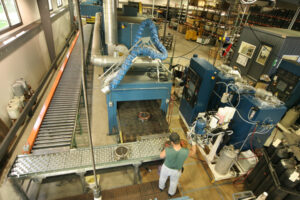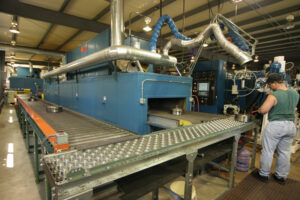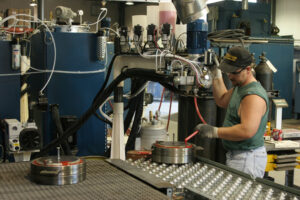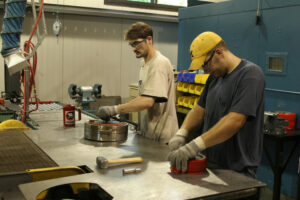The Open Casting of Polyurethane Parts Reaction Industries is a custom polyurethane molder specializing in the open casting polyurethane molding process. This process allows us to meet customer needs whether the need is large or small. We use a open casting process to mold rigid polyurethane parts by utilizing high quality steel molds that are manufactured in house. During the process we achieve a balanced mold/insert/material temperature to assure the highest quality of finish.
How does the open casting process work? Two liquid components, an isocyanate and a curative are placed in heated holding tanks. They are conditioned to the correct temperatures (approximately 180-250 degrees F), exact pressures and appropriate specific gravities. The molding machine, a meter-mix unit, pumps very exact volumes at a pre-determined ratio, into the mix chamber prior to the dispensing phase of the molding cycle. The exact flow into the chamber is controlled very closely by the constant measurement of volume and pressure in the system. The pumps are precision pumps that assure accuracy of the ratio in the mix. This is a critical part of getting high quality urethane poured to the customer’s exact specifications. In between shots the dispensing unit continuously re-circulates the isocyanate and the curative at constant pressures to keep both components uniformly conditioned and ready for dispensing.
When it is time to fill the mold, the two components, the isocyanate and the curative are injected via separate valves into the mix chamber and mixed at 4500 rpm. The mix head ensures complete mixing of the two liquids. At this time the chemical reaction begins as the mold is being filled with liquid polyurethane. The mold must be filled in a short period of time to assure a quality part. The pouring is done manually and great care is taken so no air is trapped in the material that might weaken the cross-linking of the material. To accelerate the chemical reaction a catalyst may also be used at this point to assure adequate green strength at the time of demolding and to enhance the physical properties of the material when fully cured. The pot life (time it takes for the mixed material to begin hardening) of the material varies depending on which polyurethane is being processed. The chemical reaction between the isocyanate and the curative creates exothermic heat. Temperatures may reach 250 to 350 degrees in the mold without any further heat source.
The molded part and mold is then placed in a processing oven at temperatures ranging from 350-390 degrees for approximately 7-12 minutes. During this time the chemical reaction continues to create the initial green strength of the part. Upon exiting the processing oven the part is carefully demolded before being placed in a holding container. These holding containers are then put in a post cure oven in temperatures ranging 180-200 degrees where they remain for a minimum of 16 hours. The part shrinks slightly during the curing process. This shrink factor is quite predictable and is factored into the mold design. Part designers do not need to compensate for shrink.




